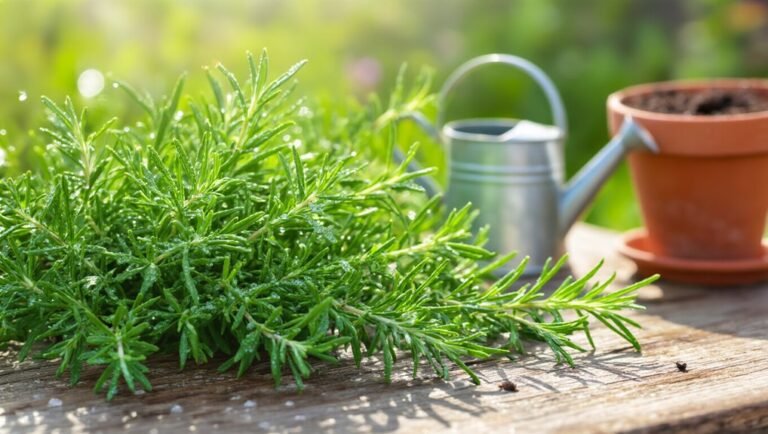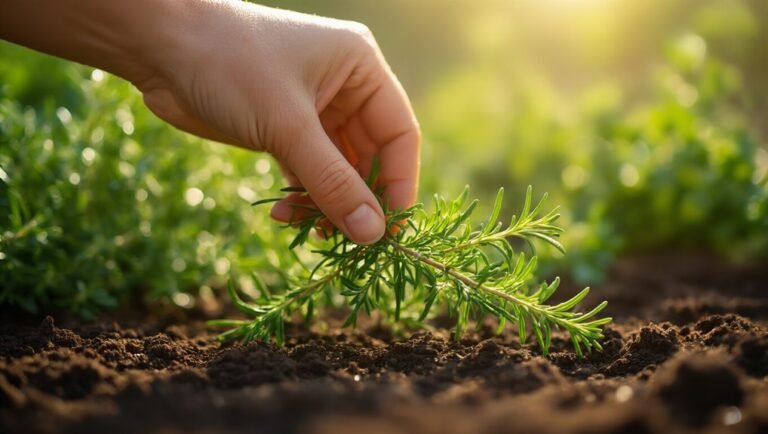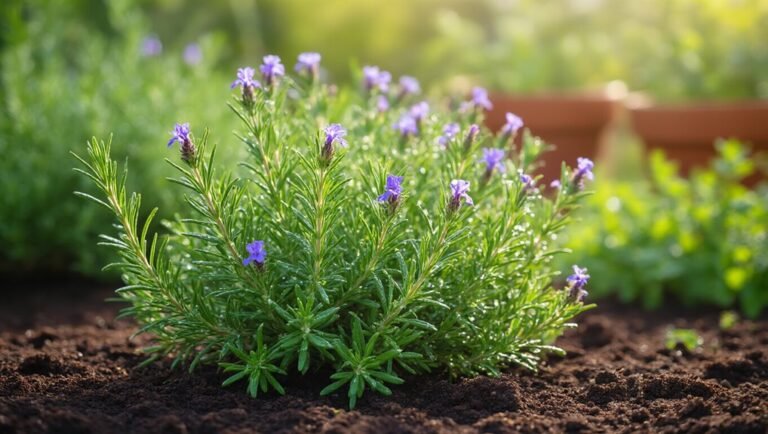To care for blue flowers, pick varieties like delphiniums or lobelias that match your space. Ensure you have loamy soil with a pH between 6.0 and 7.0, and water deeply once or twice a week, aiming at the base. They thrive in full sun, needing at least 6 hours of direct light daily. Regular deadheading and pruning can enhance growth. Keep an eye on pests and diseases for healthy blooms. There’s more to uncover about optimal care techniques.
Key Takeaways
- Choose well-draining loamy soil with a pH of 6.0 to 7.0 for optimal growth of blue flowers.
- Water deeply once or twice a week, ensuring moisture reaches the base of the plants.
- Fertilize with a balanced fertilizer in early spring to support new growth and flowering.
- Keep an eye out for pests using sticky traps and monitor for signs of fungal diseases like powdery mildew.
- Ensure blue flowers receive at least 6 hours of direct sunlight daily for robust growth and blooming.
Choosing the Right Blue Flower Varieties
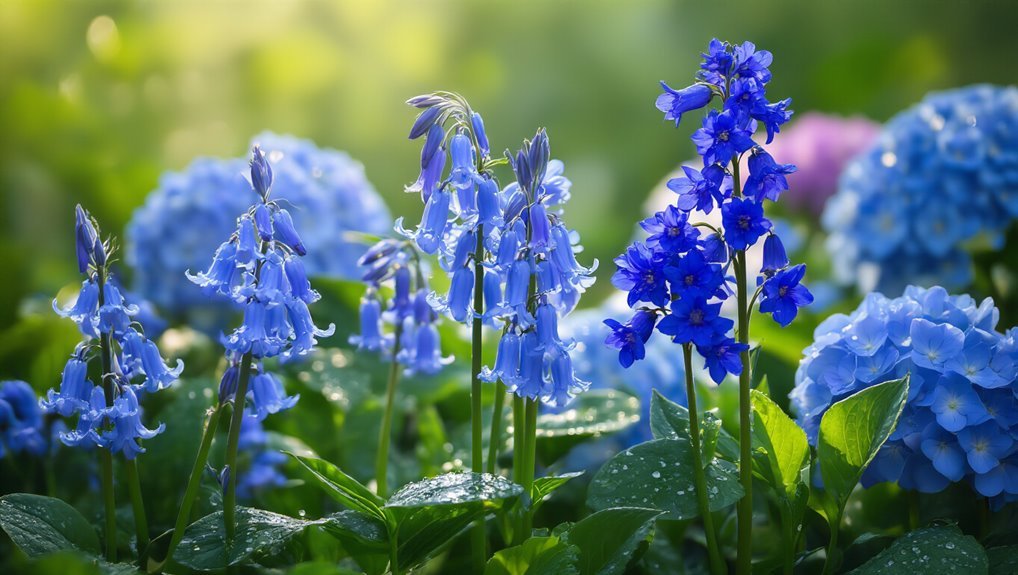
When it comes to choosing the right blue flower varieties, you’ll find a stunning array of options that can brighten up any garden.
To start, consider the type of blooms you want—some popular choices include delphiniums, lobelias, and bluebells. Each variety has its unique charm and growth habits. For gardeners who want to keep their flower beds tidy, using a hand rake can help maintain soil quality around your blue flowers.
Think about your garden’s size and layout, as tall flowers like delphiniums can create striking vertical interest, while lower-growing lobelias work well in borders or containers.
Don’t forget to check the blooming season, too; some blue flowers will flourish in spring, while others may bloom in summer or fall.
For gardeners interested in unique additions, you might also explore edible flower seeds as a way to add both beauty and utility to your garden.
Ideal Soil Conditions for Blue Flowers
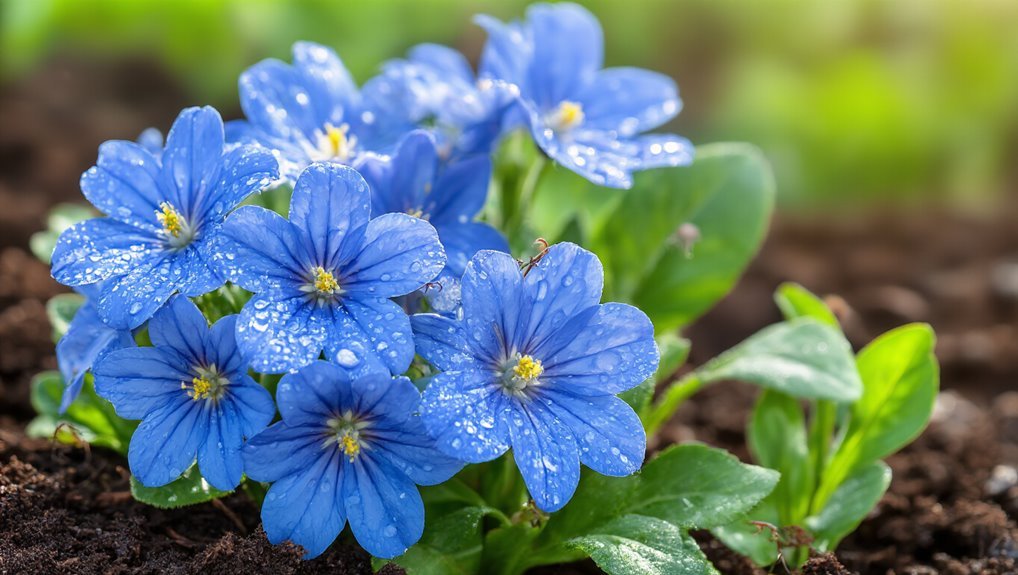
To ensure your blue flowers thrive, it’s crucial to provide them with the right soil conditions. Most blue flowers prefer well-draining, loamy soil that retains some moisture without becoming waterlogged. Applying a layer of mulch can help regulate soil temperature and conserve moisture, which is particularly beneficial during hot or dry periods. Aim for a pH level between 6.0 and 7.0, as this range supports optimal nutrient uptake. You can amend your soil with organic matter, like compost, to improve its structure and fertility.
If your soil is heavy clay, consider adding sand or perlite to enhance drainage. Always check for adequate aeration, as compacted soil can stifle root development. For added moisture retention and soil health, consider using organic mulching materials such as straw around your blue flowers.
Watering Techniques for Healthy Growth
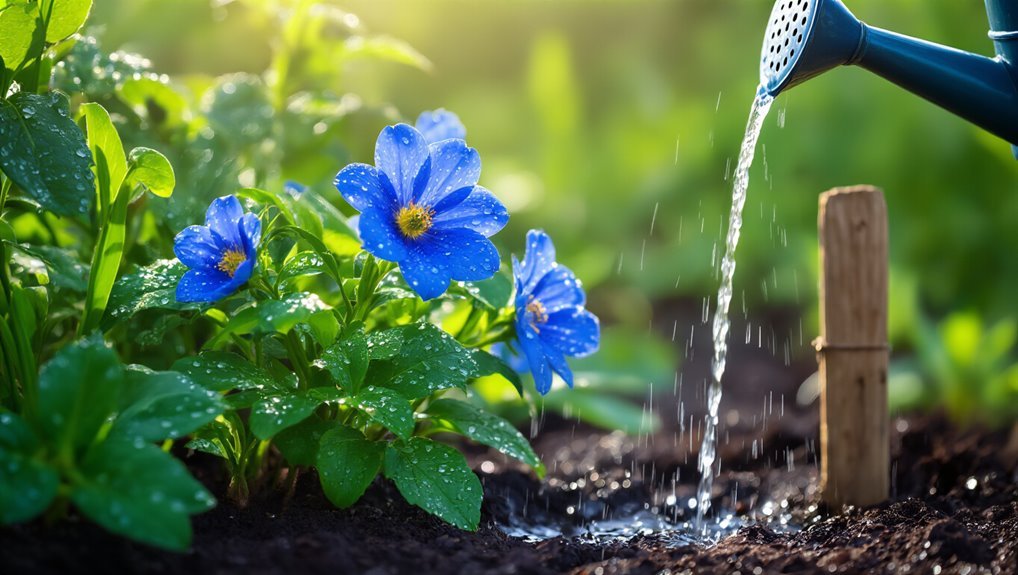
How often should you water your blue flowers for optimal growth? Generally, you should water them deeply once or twice a week, depending on your climate and soil type.
If your soil drains well, check for moisture by sticking your finger an inch deep; if it’s dry, it’s time to water. For best results, you can use a Soil Moisture Sensor to accurately monitor when your plants need water. Avoid overwatering, as this can lead to root rot.
When you do water, aim for the base of the plant rather than the leaves to prevent fungal diseases. Early morning is the best time, as it allows the soil to absorb moisture before the heat of the day.
Pay attention to your plants, and adjust your watering schedule based on their specific needs and weather conditions. For added convenience, you can consider using plant watering systems to help maintain consistent moisture levels for your blue flowers.
Sunlight Requirements and Placement
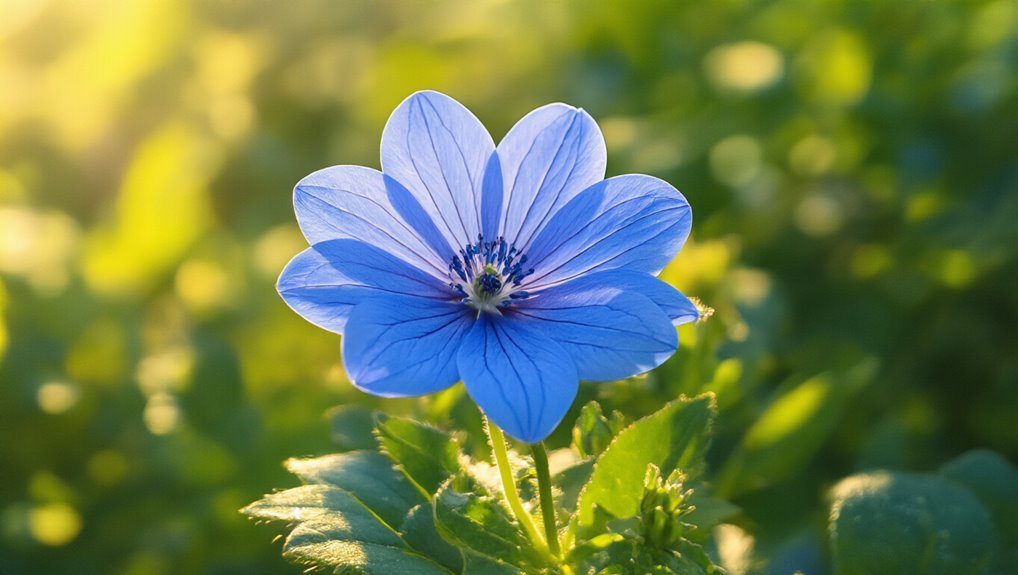
Although blue flowers thrive in various conditions, they generally prefer full sun for optimal growth. Position your flowers where they’ll receive at least 6 hours of direct sunlight daily. If you can’t provide full sun, try placing them in partial shade, but be aware that growth may slow down. For best results, use essential gardening tool sets when preparing soil and maintaining your flower beds to ensure the healthiest environment.
Here’s a quick reference table to help you choose the right placement for your blue flowers:
| Light Condition | Growth Rate | Plant Health |
|---|---|---|
| Full Sun | Fast | Strong |
| Partial Shade | Moderate | Average |
| Full Shade | Slow | Weak |
| Morning Sun | Fast | Strong |
| Afternoon Shade | Moderate | Average |
Using pruning shears regularly can also help maintain healthy growth and shape for your blue flowers. Ensure you monitor your flowers and adjust their placement as needed!
Fertilizing Your Blue Flowers
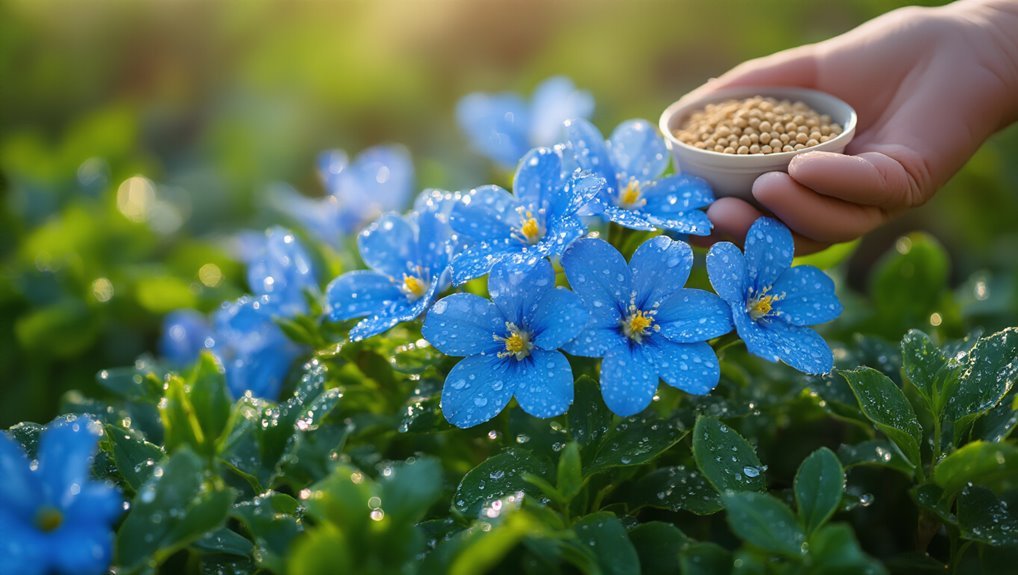
Fertilizing your blue flowers is essential for promoting vibrant blooms and healthy growth. Start by choosing a balanced fertilizer with equal parts nitrogen, phosphorus, and potassium. This combination supports overall plant health and encourages blooming.
Apply the fertilizer in early spring, just as new growth begins. Follow the instructions on the package for the correct dosage—over-fertilizing can harm your plants. Water your flowers thoroughly after application to help the nutrients penetrate the soil. For a convenient and effective solution, consider using plant fertilizer tablets to deliver nutrients directly to the roots.
Consider using a slow-release fertilizer for long-lasting effects. You might also want to feed your blue flowers every 4-6 weeks during the growing season, adjusting based on their specific needs.
For the best results, explore different plant food options to ensure your blue flowers receive all the nutrients they need. Keep an eye on their growth, and enjoy the stunning display of colors they provide!
Pruning and Deadheading for Longevity
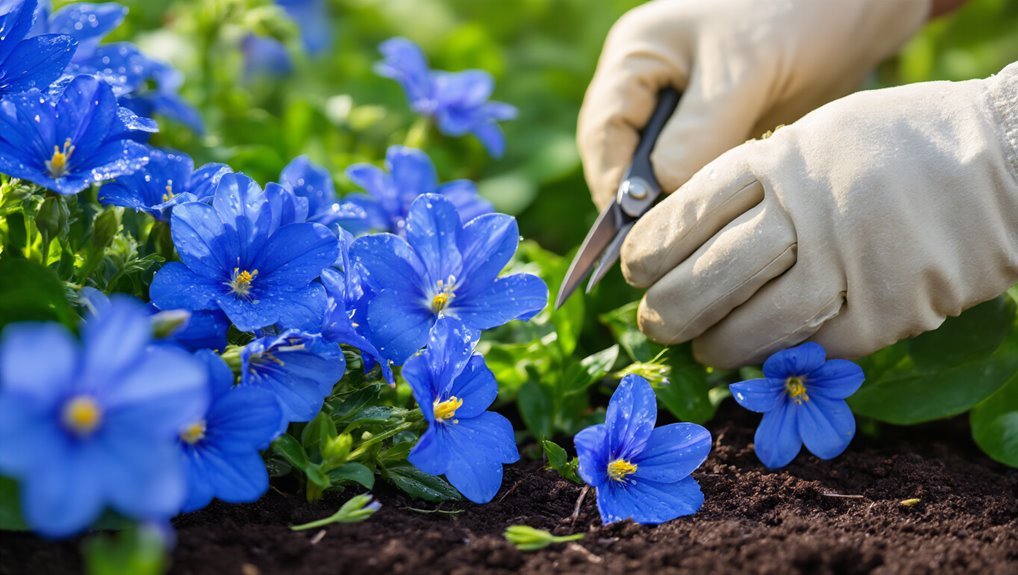
To keep your blue flowers blooming beautifully throughout the season, regular pruning and deadheading are key practices you shouldn’t overlook.
Deadheading involves removing spent blooms, which encourages your plants to focus their energy on producing new flowers instead of seed production. Use sharp, clean scissors or shears to snip off faded blossoms just above the first set of healthy leaves. For even better results, consider using essential weeding tools to tidy up the area around your blue flowers, preventing unwanted weeds from competing for nutrients.
Pruning, on the other hand, helps maintain shape and encourages bushier growth. Aim to prune your blue flowers in early spring or after the blooming period, depending on the species.
Remove any dead or damaged stems, cutting them back to healthy tissue. For best results, use a garden trowel to gently loosen soil around the base of your plants before pruning, helping to avoid root disturbance and promote healthier regrowth. By incorporating these practices, you’ll promote healthier plants and extend the blooming period, ensuring a vibrant garden.
Common Pests and Disease Management
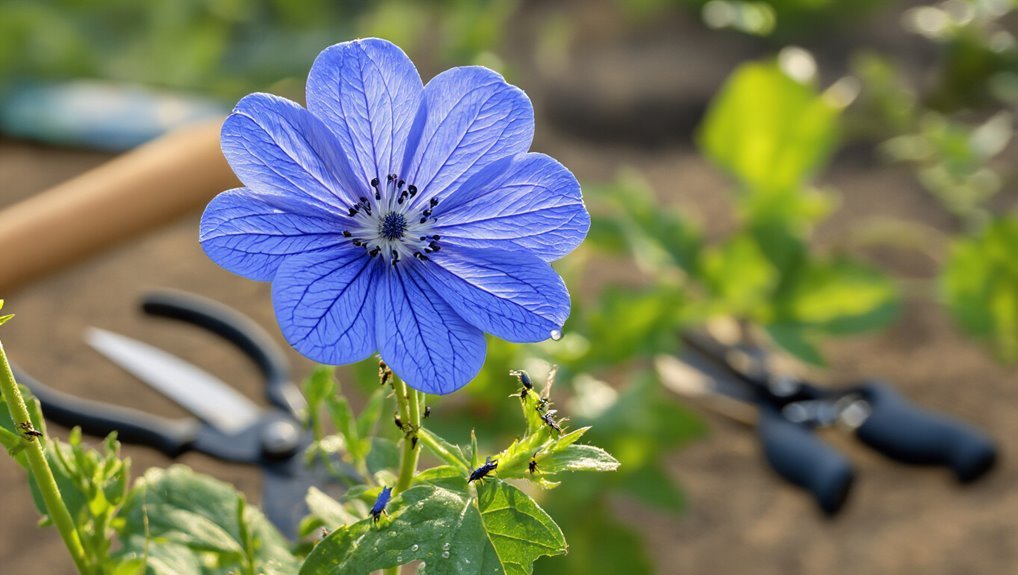
While cultivating beautiful blue flowers, you might encounter common pests and diseases that can threaten their health. Aphids, slugs, and spider mites often target these plants, so keep an eye out for any signs of damage.
To manage these pests, regularly inspect your flowers and use insecticidal soap or neem oil to eliminate infestations. For a targeted and non-toxic approach, you can also utilize sticky traps to capture and reduce pest populations around your blue flowers.
Fungal diseases like powdery mildew can also appear, especially in humid conditions. To combat this, ensure your flowers have good air circulation and avoid overhead watering.
If you notice any affected leaves, promptly remove them to prevent spreading. By staying vigilant and acting quickly, you can keep your blue flowers thriving and vibrant. For more effective protection, consider using pest control products designed specifically to target common garden pests and prevent infestations.
Frequently Asked Questions
Can Blue Flowers Attract Specific Pollinators?
Yes, blue flowers can attract specific pollinators like bees and butterflies. Their vibrant color signals to these insects that nectar is available, enhancing your garden’s biodiversity and encouraging a healthy ecosystem for all plants.
Are Blue Flowers Suitable for Container Gardening?
Yes, blue flowers can thrive in container gardening. You’ll find they add vibrant color and attract pollinators. Just ensure you choose the right pot size, soil, and provide adequate sunlight for optimal growth.
How Do I Propagate Blue Flowers?
So, you think propagating blue flowers is like baking a cake? Not quite! Just take cuttings, place them in water or soil, and watch them root. Soon, you’ll have a blue flower army!
Can Blue Flowers Thrive in Colder Climates?
Yes, blue flowers can thrive in colder climates. You’ll need to choose cold-hardy varieties and ensure they’re properly mulched. They’ll appreciate well-draining soil and some protection from harsh winds during the winter months.
What Companion Plants Work Well With Blue Flowers?
When planting your garden, think of a vibrant tapestry. Companion plants like yellow coreopsis or white daisies can enhance your blue flowers’ beauty, creating a stunning visual contrast that’ll captivate anyone who passes by.
Conclusion
By following these care tips, your blue flowers will thrive like a painter’s vivid strokes on a canvas. Choosing the right varieties, providing ideal soil, and ensuring proper sunlight will create a breathtaking display in your garden. Don’t forget to water, fertilize, and prune regularly to keep them blooming beautifully. With a little attention and love, your garden will transform into a serene oasis, where the stunning blue hues dance in the sunlight, captivating all who pass by.
